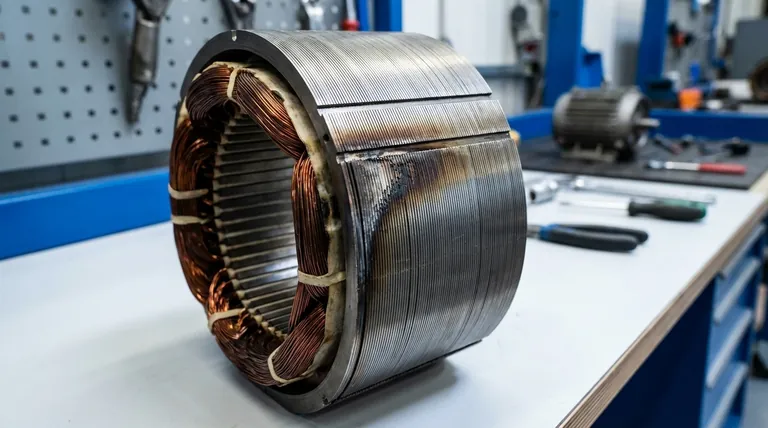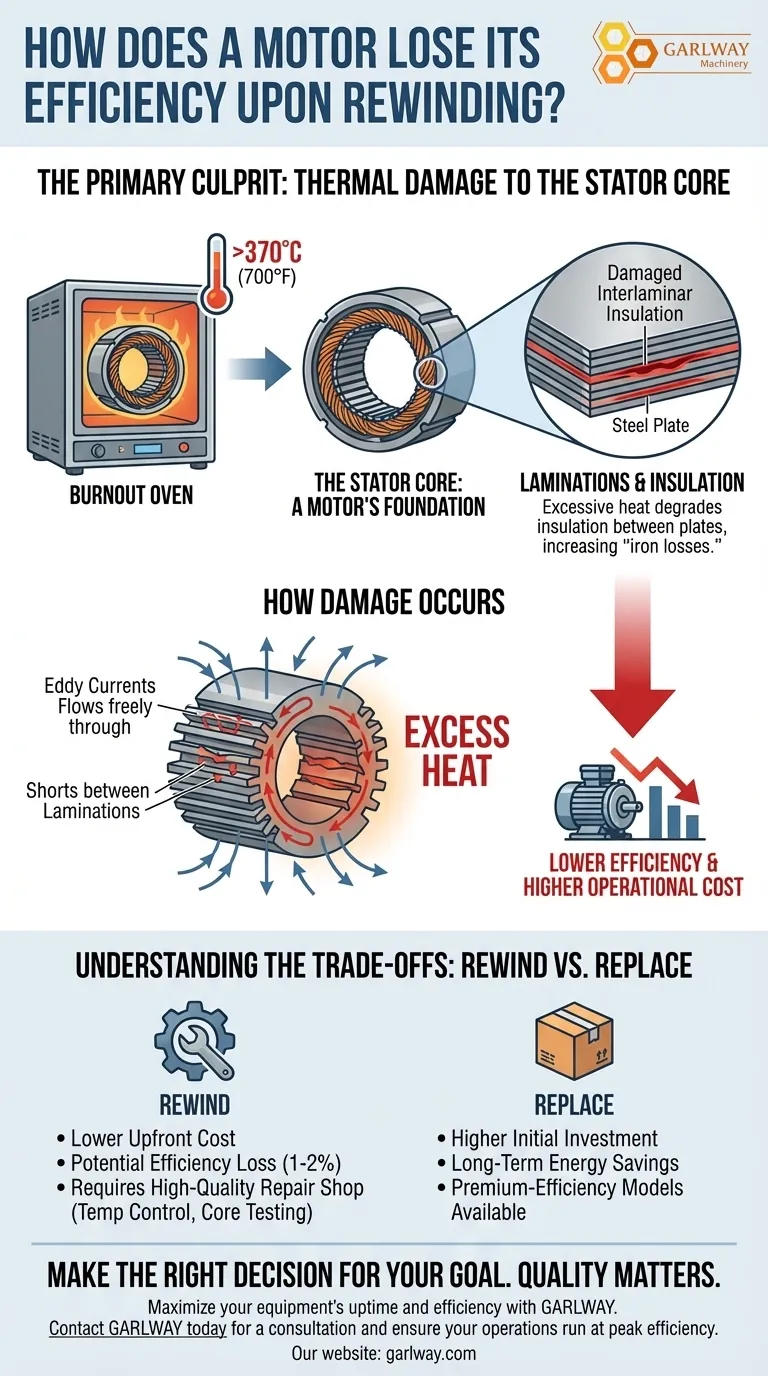The primary reason a motor can lose efficiency after rewinding is due to thermal damage to the stator core during the stripping process. The high temperatures used to burn off old winding insulation can degrade the electrical properties of the core's steel laminations, which permanently increases energy losses.
A motor's efficiency is not compromised by the new windings themselves, but by potential damage to the stator core during the teardown. The key culprit is excessive heat, which degrades the insulation between the core's steel plates, leading to higher "iron losses."

The Stator Core: A Motor's Foundation
To understand the efficiency loss, we must first understand the stator core. It isn't a solid block of steel; it's a stack of very thin, individually insulated steel plates called laminations.
Why a Laminated Core is Critical
The motor's magnetic field is constantly changing. A solid steel core would have large electrical currents—called eddy currents—induced within it by this changing field.
These eddy currents serve no useful purpose. They simply generate waste heat, which is a direct loss of motor efficiency.
The Role of Interlaminar Insulation
To prevent these losses, the stator core is built from a stack of thin steel plates (laminations), each coated with a varnish-like layer of insulation.
This insulation forces any potential eddy currents to be incredibly small, dramatically reducing the energy wasted as heat. This component is fundamental to a motor's designed efficiency.
How the Rewind Process Can Cause Damage
The potential for damage occurs when the old, failed copper windings must be removed from the stator core slots.
The Stripping Process: Applying Heat
The most common method for removing old windings is to place the stator in a burnout oven. This oven heats the assembly to a high temperature to vaporize the old winding insulation, making the copper coils easy to pull out.
Heat's Impact on Core Insulation
If the oven temperature is too high or applied for too long, it can destroy the delicate interlaminar insulation between the steel plates of the core.
The reference temperature for this damage to begin is often cited around 370°C (700°F). Poorly controlled ovens can easily exceed this limit.
The Result: Increased Iron Losses
When the interlaminar insulation is damaged, it creates shorts between the laminations. This effectively makes the core behave more like a solid piece of steel.
Eddy currents can now flow more freely through the damaged areas, generating excess heat. This permanent increase in "iron loss" means the motor will consume more electricity to produce the same amount of work, thereby operating at a lower efficiency.
Understanding the Trade-offs: Rewind vs. Replace
Choosing to rewind a failed motor is a balance between initial cost and long-term operational expense.
The Upfront Cost Advantage
Rewinding a motor is almost always cheaper than purchasing a brand-new replacement, especially for larger or more specialized motors.
The Long-Term Efficiency Penalty
Even a small drop in efficiency can be costly. A motor that runs continuously with a 1-2% efficiency loss from a poor rewind can easily consume more in extra electricity costs over a year than the initial savings of the repair.
The Quality of the Repair Shop
The risk of efficiency loss is not inevitable. Reputable motor repair shops use temperature-controlled burnout ovens and test the stator core for losses before and after the stripping process.
A high-quality rewind from a skilled technician can preserve the motor's original efficiency. The crucial factor is the shop's process control.
Making the Right Decision for Your Goal
- If your primary focus is minimizing upfront cost: Rewinding is a viable option, but you must ask the repair shop about their oven temperature controls and core testing procedures.
- If your primary focus is long-term energy savings: Replacing the failed motor with a new, premium-efficiency model is almost always the most financially sound decision.
- If your motor is specialized, obsolete, or has a long lead time: Rewinding may be your only practical choice, which makes selecting a high-quality, certified repair facility absolutely essential.
Ultimately, understanding how efficiency can be lost empowers you to ask the right questions and choose a path that aligns with your operational priorities.
Summary Table:
| Factor | Impact on Motor Efficiency |
|---|---|
| Excessive Heat During Stripping | Damages interlaminar insulation, increasing eddy currents and iron losses. |
| Quality of Rewind Process | Poor temperature control in burnout ovens (>370°C/700°F) causes permanent core damage. |
| Long-Term Operational Cost | Even a 1-2% efficiency drop can result in significant wasted electricity over time. |
Maximize your equipment's uptime and efficiency with GARLWAY.
Unsure whether to repair or replace a critical motor? Choosing the right equipment from the start is the best way to avoid costly downtime and efficiency losses. GARLWAY specializes in durable and reliable construction machinery, including winches, concrete mixers, and concrete batching plants, designed for construction companies and contractors who demand performance and longevity.
Let our experts help you select the right machinery for your project needs.
Contact GARLWAY today for a consultation and ensure your operations run at peak efficiency.
Visual Guide

Related Products
- Ready Mixer Machine for Construction Ready Mix Machinery
- Electric and Hydraulic Winch for Heavy Duty Applications
- Commercial Electric Concrete Mixer Machine HZS 50 Small Batch Plant for Sale
- Portable Concrete Mixer Machine Equipment for Mixing Concrete
- Portable Cement Mixer with Lift Concrete Machine
People Also Ask
- Can a concrete mixer be used for mortar? Understanding the trade-offs for your project
- Which type of projects require a concrete mixer? Essential Guide for Construction Pros
- What is the function of a concrete mixer machine? Achieve Consistent, High-Quality Concrete for Your Projects
- What safety considerations are important for concrete mixer operation? A Guide to Proactive Risk Management
- What was significant about Roscoe Lee's 1934 concrete mixer design? Pioneering Modular Construction Equipment



















